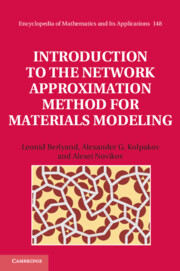Book contents
- Frontmatter
- Contents
- Preface
- 1 Review of mathematical notions used in the analysis of transport problems in densely-packed composite materials
- 2 Background and motivation for the introduction of network models
- 3 Network approximation for boundary-value problems with discontinuous coefficients and a finite number of inclusions
- 4 Numerics for percolation and polydispersity via network models
- 5 The network approximation theorem for an infinite number of bodies
- 6 Network method for nonlinear composites
- 7 Network approximation for potentials of bodies
- 8 Application of the method of complex variables
- References
- Index
3 - Network approximation for boundary-value problems with discontinuous coefficients and a finite number of inclusions
Published online by Cambridge University Press: 05 February 2013
- Frontmatter
- Contents
- Preface
- 1 Review of mathematical notions used in the analysis of transport problems in densely-packed composite materials
- 2 Background and motivation for the introduction of network models
- 3 Network approximation for boundary-value problems with discontinuous coefficients and a finite number of inclusions
- 4 Numerics for percolation and polydispersity via network models
- 5 The network approximation theorem for an infinite number of bodies
- 6 Network method for nonlinear composites
- 7 Network approximation for potentials of bodies
- 8 Application of the method of complex variables
- References
- Index
Summary
This chapter follows closely the work of Berlyand and Kolpakov (2001). The approach presented here was applied to the modeling of particle-filled composite materials. It is based on dual variational bounds and has been applied to both two-and three-dimensional problems (Berlyand et al., 2005). Further development of this approach allowed us to obtain error estimates for the network approximation (Berlyand and Novikov, 2002). It also provides answers to several unsettled physical questions, such as polydispersity at high concentration (Berlyand and Kolpakov, 2001; Berlyand and Mityushev, 2005), weak and strong blow up of the effective viscosity of disordered suspensions (Berlyand and Panchenko, 2007), and it establishes a connection between the notion of capacitance and the network approximation (Kolpakov, 2005, 2006a). Subsequently this approach was generalized for fluids. Next a new “fictitious fluid” approach was introduced in Berlyand et al. (2005). This approach led to a complete description of all singular terms in the asymptotics of the viscous dissipation rate of such suspensions and provided a comprehensive picture of microflows in highly packed suspensions. Note that previous works addressed only certain singularities and therefore provided a partial analysis of such microflows. It also allowed us to predict an anomalous singularity in two-dimensional problems (thin films) which has no analog in three-dimensions (Berlyand and Panchenko, 2007).
Information
- Type
- Chapter
- Information
- Publisher: Cambridge University PressPrint publication year: 2012
